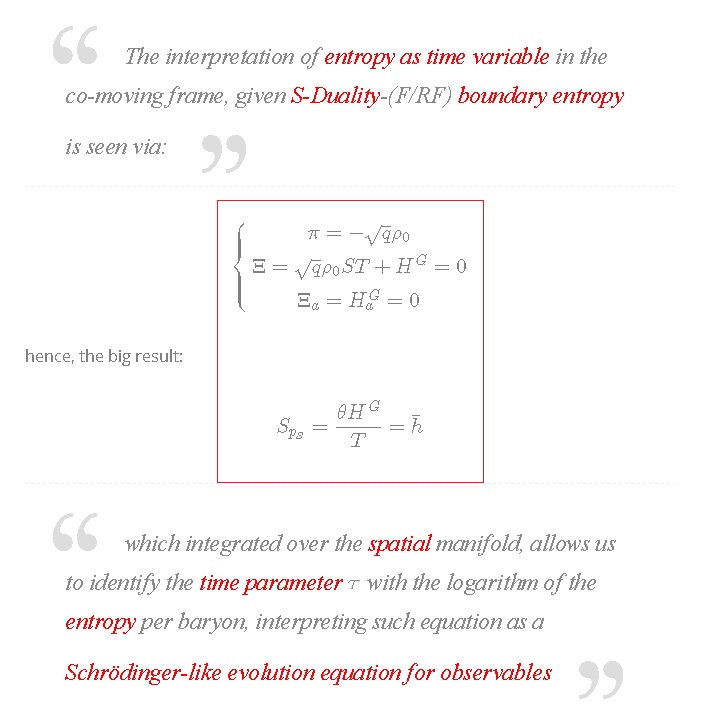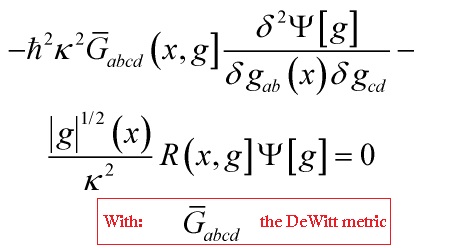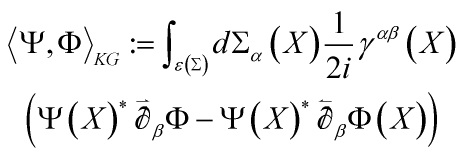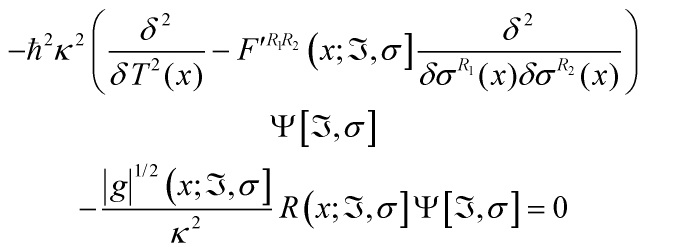Given, as I showed, that the Eulerian fluid action, after the ADM splitting, is
![]()
with
![Rendered by QuickLaTeX.com \[\left\{ {\begin{array}{*{20}{c}}{{\chi _1} = {p_\alpha } = 0}\\{{\chi _2} = {p_\beta } - \alpha \pi = 0}\\{{\chi _3} = {p_\theta } = 0}\\{{\chi _4} = {p_S} - \theta \pi }\end{array}} \right.\]](https://www.georgeshiber.com/wp-content/ql-cache/quicklatex.com-2e1fd78c49abd93bee921e0ec4546b8f_l3.png)
the entropy ![]() , given the Mandelstam-Tamm formulation of a time-energy uncertainty relation, entails the undefinability of inner products of functional differential operators for this form of the Wheeler-DeWitt equation:
, given the Mandelstam-Tamm formulation of a time-energy uncertainty relation, entails the undefinability of inner products of functional differential operators for this form of the Wheeler-DeWitt equation:
and at face value, that is a no-go theorem for the ‘existence’ of time outside of string-theory’s AdS/CFT duality, but not to be addressed here. Let me ignore the operator-ordering problem to reduce the WdW-equation to
![]()
and try and define an inner product via the Klein-Gordon interpretation of quantum gravitational geometrodynamics and proceed from there. In this section, I will lead us to a rather foundationally deep problem for time, namely: the Hilbert-Space-Problem. Let’s start with the issue of interpreting the WdW-equation, with chiefly two main philosophically and mathematically acute issues: defining an inner product and how to extract a notion of time evolution from the Wheeler-DeWitt equation. One inner-product immediately, for scalar reasons, suggests itself:
![]()
this is the Schrödinger IP-interpretation. Let me draw a parallel between the Wheeler-DeWitt equation
![]()
and the Klein-Gordon equation of a ‘particle’ moving in a curved space with an arbitrary, time-dependent potential which is valid in the minisuperspace model. So, take a relativistic particle of mass M moving in a four-dimensional spacetime ![]() where
where ![]() is a rigid Lorentzian metric. Classically, the trajectories of the particle in
is a rigid Lorentzian metric. Classically, the trajectories of the particle in ![]() are parametrised by an arbitrary real number
are parametrised by an arbitrary real number ![]() and the theory is invariant under the reparametrisation
and the theory is invariant under the reparametrisation ![]() . Note, this invariance leads to the constraint
. Note, this invariance leads to the constraint ![]() and the superHamiltonian
and the superHamiltonian
![]()
This constraint becomes the Klein-Gordon equation in the quantum theory:
![]()
Here is the deep point, any interpretation of this equation is based on the pairing between any pair of solutions  ,
,  defined by
defined by
and the integral is taken over the hypersurface ![]() of
of ![]() defined by an embedding
defined by an embedding ![]() that is spacelike with respect to the background metric
that is spacelike with respect to the background metric ![]() , with crucially:
, with crucially:
![]()
Hence, the Klein-Gordon equation entails that ![]() is independent of
is independent of ![]() , thus
, thus ![]() is the right choice for a scalar product. Yet, we have a problem, since it is not positive-definite:
is the right choice for a scalar product. Yet, we have a problem, since it is not positive-definite:
![]()
holds for all real functions ![]() , and complex solutions to the Klein-Gordon equation exist for which
, and complex solutions to the Klein-Gordon equation exist for which ![]() .
.
A classic resolution is looking for a timelike vector field ![]() that is a Killing vector for the spacetime metric and is also such that the potential is constant along its flow lines. A choice of time function is naturally
that is a Killing vector for the spacetime metric and is also such that the potential is constant along its flow lines. A choice of time function is naturally ![]() and is the parameter along these flow lines, defined as a solution to the partial differential equation:
and is the parameter along these flow lines, defined as a solution to the partial differential equation:
![]()
it follows that the energy
![]()
of the particle is a constant of the motion with ![]() . Now, upon quantisation, we get
. Now, upon quantisation, we get
![]()
such that if all the operators are self-adjoint with respect to the inner product
![]()
it would mean it is possible to find simultaneous eigenstates of
![]()
and
![]()
Thus it makes sense to select those solutions of the Klein-Gordon equation that have positive energy, and one can see that the inner product
is positive on such solutions. On such a class of solutions, and this is key, the Klein-Gordon equation is equivalent to the standard Schrödinger equation using the above chosen time parameter.
In applying these ideas to the Wheeler-DeWitt equation
the key is that the DeWitt metric
on  has a hyperbolic character in which the conformal modes of the metric play the role of time-like direction
has a hyperbolic character in which the conformal modes of the metric play the role of time-like direction
which entails that it is possible to choose an internal time functional ![]() so that the Wheeler-DeWitt equation takes the following form:
so that the Wheeler-DeWitt equation takes the following form:
with ![]() ,
, ![]() = 1, . . ., 5 denoting the
= 1, . . ., 5 denoting the ![]() modes of the metric variables
modes of the metric variables ![]() that remain after identifying the
that remain after identifying the ![]() internal time modes
internal time modes ![]() .
.
So, we start with the formal pairing analogue of the point-particle expression:
and get:
between solutions ![]() and
and ![]() of the Wheeler-DeWitt equation and in the minisuperspace setting, the Wheeler-DeWitt equation:
of the Wheeler-DeWitt equation and in the minisuperspace setting, the Wheeler-DeWitt equation:
![]()
simplifies due to multiplication of both sides by
![]()
to yield:
![]()
with the corresponding scalar product
![]()
which is conserved in ![]() -time by virtue of:
-time by virtue of:
![]()
Things look good until one realizes that the right hand side of:







